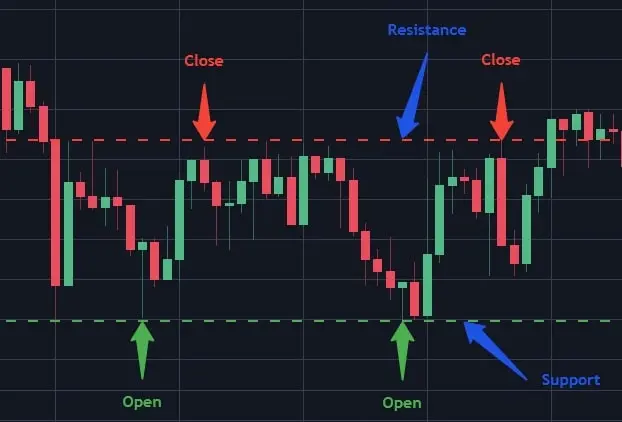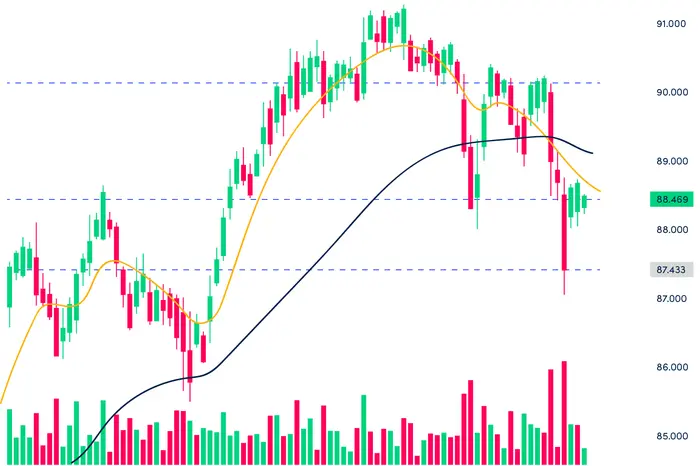Crypto options trading opens up new ways for you to profit from cryptocurrency market movements without directly buying or selling the assets. These financial tools let you make strategic bets on whether prices will go up or down, while limiting your potential losses.
You can use strategies like covered calls to generate income from your existing crypto holdings, or protective collars to shield your investments from major market drops. These approaches work similarly to traditional stock options but are specifically designed for digital assets like Bitcoin.
Trading crypto options requires careful planning and risk management.
You’ll need to choose the right strike prices, expiration dates, and position sizes based on your goals and market outlook.
Starting with basic strategies and small positions helps you learn the mechanics before moving to more complex trades.
Understanding Crypto Options

Crypto options provide traders with flexible tools to manage risk and maximize potential returns in the digital asset market. These derivative contracts let you buy or sell cryptocurrencies at set prices within specific time periods.
Options Basics
An option contract gives you the right, but not the obligation, to buy or sell cryptocurrency at a specific price before the expiration date. The strike price is the set price at which you can exercise the option.
Key terms to know:
- Premium: The upfront cost you pay to buy an option
- Expiration date: When the contract ends
- Strike price: The agreed-upon trading price
- Underlying asset: The cryptocurrency the option is based on
Call and Put Options in Cryptocurrency
Call options let you buy crypto at the strike price. You’d buy calls when you expect prices to rise. Your potential profit is unlimited while risk is limited to the premium paid.
Put options give you the right to sell crypto at the strike price. Puts are useful when you think prices will fall. The maximum profit is the strike price minus the premium.
Trading example:
- Bitcoin price: $50,000
- Call option strike: $52,000
- Premium paid: $2,000
- Breakeven: $54,000
The Role of Volatility in Crypto Options
Crypto market volatility directly affects option premiums. Higher volatility means higher premiums because there’s more uncertainty about future prices.
Important volatility factors:
- Market sentiment
- News and events
- Trading volume
- Price swings
Time decay also impacts option values. Options lose value as they get closer to expiration, which affects your trading decisions and risk management.
The implied volatility shows what the market expects for future price movements. This helps you assess if options are expensive or cheap.
Crypto Options Trading Strategies

Trading crypto options requires careful planning and execution to manage risks while maximizing potential returns. A structured approach to position sizing and strike price selection forms the foundation of successful options trading.
Risk Management in Options Trading
Position sizing is critical in crypto options trading. Never risk more than 1-2% of your portfolio on a single trade.
Set clear stop-loss levels before entering any position. These predetermined exit points help protect your capital from significant losses.
Use diversification across different expiration dates and strike prices to spread risk. This creates a balanced portfolio that can weather market volatility.
Keep detailed records of your trades, including entry points, exit targets, and rationale. This data helps you analyze and improve your strategy over time.
Selecting the Right Strike Price
Strike price selection directly impacts your probability of profit. In-the-money options offer higher probability but cost more in premiums.
Check implied volatility before choosing strikes. High IV means expensive options, while low IV can present buying opportunities.
Match strike selection to your market outlook. Bullish traders often pick strikes slightly above market price, while bearish traders look below.
Consider time decay when selecting expiration dates. Options lose value faster in their final weeks, making shorter-dated contracts riskier.
Calculate your break-even point by adding the premium paid to the strike price for calls, or subtracting it for puts.
Bullish Market Strategies
When traders expect cryptocurrency prices to rise, specific options strategies can help maximize profits while managing risk levels.
Long Call Strategy
A long call gives you the right to buy crypto at a set price before the option expires. You’ll pay a premium upfront for this right.
The potential profit is unlimited if prices rise above your strike price. Your maximum loss is limited to the premium paid.
Key points:
- Buy calls when you expect significant upward price movement
- Lower upfront cost compared to buying actual crypto
- Higher leverage potential with less capital required
Bull Call Spread
This strategy involves buying a call option at a lower strike price while selling another call at a higher strike price. Both calls have the same expiration date.
Benefits:
- Lower cost than a single long call
- Defined maximum loss (net premium paid)
- Capped but predictable profit potential
Example setup:
- Buy BTC call at $40,000 strike
- Sell BTC call at $45,000 strike
- Maximum profit achieved if price rises above $45,000
- Break-even point is lower strike plus net premium paid
Your risk is limited to the difference between what you pay for the first call and receive for selling the second call.
Bearish Market Strategies
Trading crypto options during market downturns requires specific strategies to protect your capital and potentially profit from declining prices.
Long Put Strategy
A long put strategy gives you the right to sell crypto at a set price, even if the market price drops lower. When you buy put options, your maximum loss is limited to the premium paid.
You can buy put options with different strike prices and expiration dates to match your market outlook. The further out-of-the-money you go, the cheaper the premium but lower probability of profit.
Your profit potential increases as the crypto price falls below your strike price. The break-even point is the strike price minus the premium paid.
Consider starting with at-the-money puts that expire in 30-60 days. This provides a good balance of cost and time decay.
Bear Put Spread
A bear put spread involves buying a put option while selling another put with a lower strike price. This reduces your cost but caps your maximum profit.
The trade-off is worth it in many cases. Your break-even point improves compared to a long put since the premium received partially offsets what you paid.
Choose strike prices based on where you expect the crypto to trade. A common approach is buying puts slightly in-the-money and selling puts out-of-the-money.
Keep position sizes small relative to your account. While spreads limit risk, losses can still occur if prices move against you.
Neutral Market Strategies
Neutral market strategies let you profit from an asset’s volatility rather than its price direction. These approaches work best when you expect minimal price movement or want to reduce directional risk.
Straddle Strategy
A straddle involves buying both a put and call option at the same same strike price and expiration date. You profit when the asset makes a large move in either direction.
The maximum loss equals the total premium paid for both options. Your breakeven points sit above and below the strike price by the amount of the total premium.
This strategy works well when you expect increased volatility but are unsure of direction. Major events like protocol upgrades or regulatory announcements create good opportunities.
Strangle Strategy
A strangle uses out-of-the-money calls and puts with the same expiration but different strike prices. This costs less than a straddle since both options start worthless.
You need a larger price move to profit compared to a straddle. The tradeoff is lower upfront cost and risk.
This approach fits when you predict high volatility but want to reduce premium costs. The wider the strike prices, the cheaper the strategy becomes.
Complex Strategies for Experienced Traders

Advanced crypto options strategies let you profit in various market conditions while managing risk through multi-leg positions. These methods require careful planning and precise execution.
Iron Condor
An iron condor combines four options contracts at different strike prices. You sell one put and one call while buying another put and call further out of the money.
This strategy works best when Bitcoin trades sideways within a specific price range. Your maximum profit occurs when the price stays between your short strikes at expiration.
The key benefit is collecting premium from both sides while limiting potential losses. Your risk is capped at the difference between strike prices minus the premium received.
Butterfly Spread
A butterfly spread uses three different strike prices with a total of four options contracts. You buy one contract at a lower strike, sell two at the middle strike, and buy one at a higher strike.
This strategy costs little to set up since the premiums mostly offset each other. Your maximum profit happens when the crypto price lands exactly at the middle strike at expiration.
The position has limited downside risk. You can only lose the initial premium paid if the price moves far in either direction.
The tight profit zone makes timing crucial. You need precise market analysis to predict when prices will stabilize at your target level.
Hedging with Crypto Options
Crypto options give traders powerful tools to protect their investments against market volatility and unexpected price movements.
Hedging Basics
Hedging works by opening positions that move in opposite directions. If you hold Bitcoin and want to protect against price drops, you can buy options that gain value when Bitcoin falls.
Hedging crypto positions helps limit potential losses while keeping some upside potential.
You might spend 2-3% of your investment value on option premiums as “insurance” against bigger losses.
The main goal is risk management, not profit. Think of hedging like buying insurance – you pay a small fee to protect against larger losses.
Protective Puts and Calls
Put options protect against price drops in your crypto holdings. If you own Bitcoin, buying put options lets you sell at a set price even if market prices fall lower.
Call options hedge short positions against rising prices. If you’ve borrowed and sold crypto, calls let you buy back at a fixed price if the market moves up.
You can adjust your hedge ratio based on market conditions. A 25% hedge protects against smaller moves while a 100% hedge provides maximum protection.
The cost of options increases with longer time periods and more volatile markets. Weekly options cost less but need more frequent renewal than monthly ones.
Executing Trades and Order Types
Trading crypto options requires knowledge of different order types and proper execution methods to maximize profits while managing risks. These tools help you control your entry and exit points with precision.
Order Execution in Crypto Options
You need to pick the right moment to enter or exit an options trade. The best execution happens when market liquidity is high, typically during regular trading hours.
Key execution factors:
- Volume: Higher trading volume means better price fills
- Spread: Tighter bid-ask spreads reduce your trading costs
- Time: Market hours affect liquidity and execution quality
Watch the order book depth before placing large trades. Breaking up big orders into smaller pieces often gets you better prices.
Types of Orders
Market orders fill immediately at the best available price. They guarantee execution but not price.
Limit orders let you set your desired price. The trade only happens if the market reaches your specified level.
Common order types:
- Stop-loss: Exits your position if losses reach a certain point
- Take-profit: Locks in gains at a preset price target
- Good-til-canceled (GTC): Stays active until filled or canceled
- Fill-or-kill (FOK): Must fill completely or cancels automatically
Set stop-losses to protect your capital. Many traders use a combination of order types to manage their positions effectively.
Tools and Platforms for Crypto Options Trading
The right tools and crypto options trading platforms make a big difference in crypto options trading success.
Professional traders rely on advanced charting software and trusted exchanges to execute their strategies effectively.
Charting and Analysis Tools
TradingView stands out as a popular charting platform with built-in indicators and drawing tools.
You can analyze price patterns, spot trends, and mark key support/resistance levels.
Technical indicators like RSI, MACD, and Bollinger Bands help identify potential entry and exit points.
These tools work together to inform your trading decisions.
Essential analysis tools include:
- Price charts with multiple timeframes
- Volume indicators
- Options chain analytics
- Volatility measurements
- Position sizing calculators
Popular Trading Platforms
Binance and Deribit lead the crypto options trading space with high liquidity and reliable execution.
Both platforms offer mobile apps and advanced trading interfaces.
Key platform features to look for:
- Real-time order books
- Multiple order types
- Position builder tools
- Risk management settings
- Portfolio tracking
Trading fees vary between platforms.
Deribit charges 0.03% to 0.05% per trade, while Binance fees range from 0.02% to 0.04% based on volume.
Make sure to choose a platform that matches your trading style and experience level.
Most exchanges offer demo accounts to practice without risking real money.
Legal and Regulatory Considerations
Trading crypto options requires careful attention to regulations and compliance requirements to avoid legal issues.
Staying compliant protects you and your trading activities.
Crypto Options and Regulation
Crypto options face regulatory oversight from multiple agencies like the SEC and CFTC.
You need to verify if your chosen options qualify as securities under federal law, as this affects how you can trade them.
The regulatory landscape changes often.
Keep track of new rules and guidelines that may impact your trading activities.
Work with regulated exchanges and platforms that follow compliance standards.
Many jurisdictions require registration and licensing for trading crypto derivatives.
Check local laws before starting options trading.
Know Your Customer (KYC) and Anti-Money Laundering (AML)
You must complete KYC verification on regulated platforms.
This means providing valid ID and proof of address before trading.
Platforms track trading patterns to prevent money laundering.
Large or suspicious transactions may trigger additional verification requirements.
Keep detailed records of your trades and transactions.
Document the source of funds used for trading. This helps demonstrate compliance with AML regulations.
Key compliance steps:
- Complete identity verification
- Maintain transaction records
- Report suspicious activity
- Follow platform trading limits
- Monitor regulatory changes
Frequently Asked Questions
Trading crypto options requires specific knowledge about strategies, platforms, and risk management techniques.
Success depends on choosing the right approach and tools for your experience level and goals.
What are the most effective strategies for beginners in crypto options trading?
Start with basic strategies like covered calls and protective puts. These limit your potential losses while you learn the market. Focus on one cryptocurrency at first, typically Bitcoin or Ethereum. This helps you understand price movements better. Set strict position limits of 1-2% of your trading capital per trade to protect yourself from major losses.
Which platforms are considered the best for crypto options trading in the US?
CME Group offers regulated Bitcoin and Ethereum options with high liquidity and strong security measures.
Deribit provides a wide range of strike prices and expiration dates for crypto options. FTX US and Binance US maintain user-friendly interfaces suited for both new and experienced traders.
How can one trade crypto options on Robinhood?
Robinhood does not currently support direct crypto options trading. You can trade crypto directly or stock options, but not cryptocurrency options. Consider using dedicated crypto exchanges that specifically offer options trading capabilities.
What are the most successful strategies for trading options in cryptocurrency?
Straddles work well during high volatility periods when you expect large price movements. Iron condors can generate income during sideways market conditions. Calendar spreads help capitalize on time decay while limiting risk exposure.
Can one achieve profitability through trading crypto options and what are the influencing factors?
Profitability depends on market analysis skills, risk management, and trading discipline. Market volatility, trading fees, and spread costs impact your potential returns. Successful traders typically spend 3-6 months learning before achieving consistent profits.
What considerations should be made when selecting a strategy for trading Bitcoin options?
Your risk tolerance and available trading capital should guide strategy selection. Market conditions and volatility levels heavily influence strategy effectiveness. Time commitment matters – some strategies require active management while others need less monitoring.
